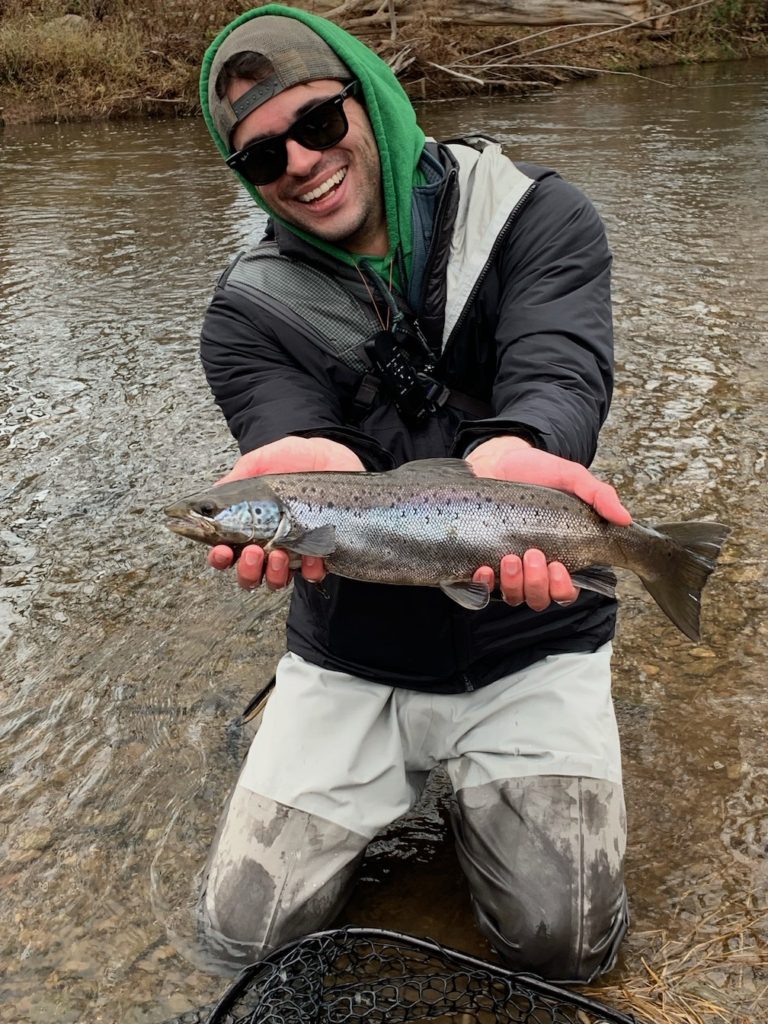The Atlantic Salmon

The Atlantic salmon (Salmo salar) is a cold-water sport fish found in Lake Ontario and its tributaries. Atlantic salmon typically range between 16 and 28 inches in length and can be identified by their silver bodies, dull gray/green backs, and large black spots that are scattered sparsely over their bodies. Atlantic salmon will retain their silver color until moving into creeks and rivers to spawn. During the spawn, Atlantic salmon begin to turn darker in color, becoming dark gray with undertones of dull yellow-brown on their bellies.
Atlantic salmon are one of many anadromous salmonids found in western New York and are a popular sportfish. Atlantic salmon can be distinguished from Chinook salmon, Coho salmon, and steelhead by the large black spots that are found across their bodies including their gill plates. The black speckles on Chinook, Coho, and steelhead are much smaller and are not pronounced on the gill plate. It can be much more difficult to distinguish Atlantic salmon from brown trout. The easiest way to distinguish an Atlantic salmon from brown trout is by the shape of its tail. An Atlantic salmon has more of a forked tail, while a brown trout’s tail is more or less flat.
Habitat
Atlantic salmon are anadromous fish, meaning they reside in a large body of water before swimming up creeks and rivers to spawn. Atlantic salmon will live in the deep water of Lake Ontario for most of their lives. Once they reach sexual maturity, Atlantic salmon swim up creeks and rivers where they spawn. During the spawn, Atlantic salmon typically hold in deep pools and runs in creeks and rivers. Although Atlantic salmon don’t face programmed post-spawn death like their Pacific cousins, it is likely that their post-spawn survival rate is very low.
Lake Ontario is especially conducive to sustaining salmon populations because of its depth. Lake Ontario has a maximum depth of 801 feet and can therefore maintain the cold water temperatures needed for salmon survival year round. In Lake Ontario, Atlantic salmon cruise the water column, typically at depths below 80 feet, feeding on baitfish. Although once abundant in Lake Ontario, the native population of Atlantic salmon has been all but completely wiped out. Current runs of Atlantic salmon out of Lake Ontario are supported through stocking programs.
Food
When residing in Lake Ontario, Atlantic salmon feed on baitfish. The plentiful supply of baitfish in Lake Ontario allows Atlantic salmon to reach good sizes in only a few years. Once they enter creeks and rivers, Atlantic salmon do not feed aggressively. However, they can and will actively take baits presented properly and are generally much more apt to strike during the spawn than the Pacific salmons.
Where to Catch Atlantic Salmon
Lake Ontario maintains a population of Atlantic salmon, but they are usually few and far between. Atlantic salmon are nonexistent in Lake Erie (to my knowledge). Therefore, the best place to target Atlantic salmon in western New York is the Niagara Frontier including Niagara and Orleans Counties. Better numbers of Atlantic salmon are found in the Finger Lakes region of New York State.
In the summer, Atlantic salmon reside in Lake Ontario and cannot be caught in tributaries. Atlantic salmon are most often caught by chance in the summer by anglers trolling for the Pacific salmons in deep water with a boat. It is rare for anglers to specifically target Atlantic salmon on Ontario because of their relatively low numbers.
The only time to target Atlantic salmon without a boat is during the run. The salmon run usually begins in September and peaks in mid to late October; however, Atlantic salmon usually show a bit later than the Pacific salmons and can sometimes hang around through December. During the run, Atlantic salmon can be caught in most Lake Ontario tributaries, but the Oak Orchard River and surrounding tributaries seem to have the highest catch rates. When fishing these streams, you will not be alone. During the height of the salmon run, anglers can sometimes seem to outnumber the fish!
How to Catch Atlantic Salmon
Fly-fishing is one popular method for targeting Atlantic salmon in creeks and rivers. Productive baits for Atlantic salmon include egg patterns and streamers. It is usually best to fish egg patterns under an indicator with split shot weight added about 1 foot from the hook. Enough split shot should be added so that your weight reaches and drags on the bottom of the stream.
Swinging streamers is another good option. Flashy, colorful streamers are often a good bet, but wooly buggers in black or olive also work well. Although Atlantic salmon are not necessarily aggressively feeding during the spawn, a well-presented fly can easily entice an Atlantic to eat.
Spin fishing is another way to target Atlantic salmon during the run. Contrary to the belief of many, salmon WILL strike bait during the run. Snagging is NOT the only way to catch salmon and is ILLEGAL. Productive baits for the spin fisherman include egg sacs, trout beads, spinners, and jigs. Fishing egg sacs or trout beads under a float is especially popular amongst salmon anglers on Lake Ontario tributaries.
There is some good information regarding salmon fishing in western New York on the NYS DEC website including public fishing access maps: http://www.dec.ny.gov/outdoor/62216.html
